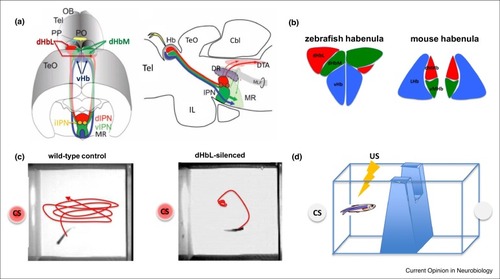Fig. 1
- ID
- ZDB-FIG-220202-1
- Publication
- Okamoto et al., 2021 - Habenula as the experience-dependent controlling switchboard of behavior and attention in social conflict and learning
- Other Figures
- All Figure Page
- Back to All Figure Page
|
(a) Schematic illustration showing dorsal oblique view (left panel) and lateral view (right panel) of the zebrafish dHb-IPN pathways. OB: olfactory bulb; Tel: telencephalon; P: pineal organ; PP: parapineal organ; TeO: tectum opticum; Cbl: cerebellum; IL: inferior lobe of hypothalamus; MR: median raphe; DR: dorsal raphe; DTA: dorsal tegmentum area; MLF: medial longitudinal fascicle. (b) Comparison between the zebrafish and mouse Hb subnuclear structure. The evolutionarily corresponding structures are labeled with the same colors both in the zebrafish and mouse habenula. dHbL, the lateral subregion of the dorsal habenula; dHbM, the medial subregion of the dorsal habenula; vHb, the ventral habenula; dMHb, the dorsal subregion of the medial habenula; vMHb, the ventral subregion of the medial habenula; LHb, the lateral habenula. (c) The trajectories of the wild-type (left panel) and dHbL silenced (right panel) zebrafish after presentation of the conditioned stimulus (CS, red light). (d) Schematic illustration of the apparatus for active avoidance test. US, unconditioned stimulus (electrical shock). |

